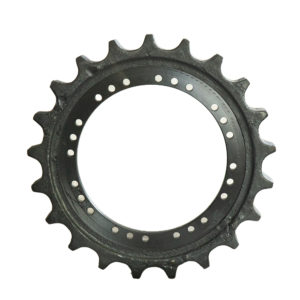The design of an excavator sprocket rim plays a significant role in determining its performance and durability.
Here’s how different design factors can impact the performance of an excavator sprocket rim:
- Material Selection: The choice of materials for the sprocket rim greatly affects its performance. High-quality materials such as forged steel or alloy steel are commonly used due to their strength, hardness, and resistance to wear and fatigue. The material should be selected based on the specific requirements of the application, considering factors such as load capacity, operating conditions, and expected service life.
- Tooth Profile: The design of the sprocket teeth, including their shape, size, and spacing, influences the engagement with the excavator’s track links. A properly designed tooth profile ensures efficient power transmission, smooth operation, and minimal wear on the track links and sprocket teeth. Different tooth profiles may be used for specific applications, such as heavy-duty digging or fine grading.
- Number of Teeth: The number of teeth on the sprocket rim determines the pitch circumference and the engagement with the track links. The optimal number of teeth depends on factors such as the size of the excavator, track configuration, and intended application. A higher number of teeth can distribute the load more evenly across the sprocket rim, reducing wear and extending the service life.
- Heat Treatment: Proper heat treatment of the sprocket rim is essential to enhance its hardness, strength, and resistance to wear and deformation. Heat treatment processes such as quenching and tempering help improve the material’s mechanical properties and ensure consistent performance under heavy loads and harsh operating conditions.
- Surface Coatings and Treatments: Surface coatings or treatments may be applied to the sprocket rim to further enhance its performance and durability. Coatings such as hard chrome plating or carbide deposition can provide additional protection against wear, corrosion, and abrasion, China excavator Sprocket Rim suppliers extending the service life of the sprocket rim in challenging environments.
- Hub Design: The design of the hub where the sprocket rim mounts onto the excavator’s drive shaft or axle is critical for ensuring proper alignment, stability, and power transmission. A robust hub design with precise machining tolerances and secure fastening mechanisms is essential to prevent slippage, vibration, and premature wear of the sprocket rim.
- Weight Distribution: The distribution of weight and material thickness across the sprocket rim should be optimized to minimize stress concentrations and ensure uniform loading under operating conditions. A well-balanced design helps prevent deformation, cracking, and premature failure of the sprocket rim, particularly in high-stress areas such as the tooth roots and rim edges.
- Alignment and Geometry: The alignment and geometry of the sprocket rim should be carefully engineered to ensure proper meshing and engagement with the track links. Misalignment or geometric errors can lead to uneven wear, increased friction, and reduced efficiency of the excavator’s drive system. Precision manufacturing techniques and quality control measures are essential to maintain tight tolerances and ensure optimal performance of the sprocket rim.
Overall, the design of an excavator sprocket rim plays a critical role in its performance, reliability, and longevity. By carefully considering factors such as material selection, tooth profile, heat treatment, surface coatings, hub design, weight distribution, and alignment, manufacturers can optimize the design to meet the specific requirements of the excavator and its operating environment, ensuring smooth operation, minimal downtime, and maximum productivity.
